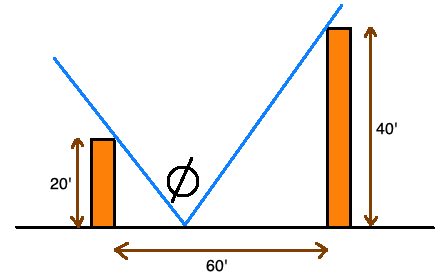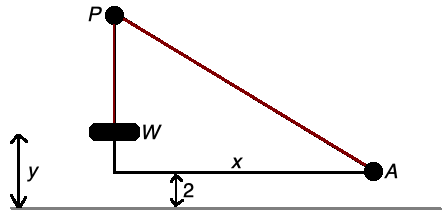Optimization calculus problems
Inscribed Rectangle Optimization example question
Find the area of the largest rectangle that can be inscribed in a circle of radius 4.
Solution to this Calculus Optimization practice problem is given in the video below!
Rain Gutter Optimization example problem
A rain gutter is to be constructed from a metal sheet of width 30 centimeters by bending up one-third of the sheet on each side through an angle θ. How should angle θ be chosen so that the gutter will carry the maximum amount of water?
Solution to this Calculus Optimization practice problem is given in the video below!
Distance Optimization example
Find the point on the curve y = cos(x) closest to the point (0,0)
Solution to this Calculus Optimization practice problem is given in the video below!
Running Track Optimization example question
A running track is to be built around a rectangular field, with two straightaways and two semicircular curves at the ends, as indicated in the figure. The length of the track is to be 400 meters. Find the dimensions that will maximize the area of the enclosed rectangle.
Solution to this Calculus Optimization practice problem is given in the video below!
Ticket Cost Optimization example problem
Suppose that group tickets to a concert are priced at $40 per ticket if 20 tickets are ordered, up to a maximum of 50 tickets. (For example, if 22 tickets are ordered, the price is $38 per ticket). Find the number of tickets that maximizes the total cost of the tickets.
Solution to this Calculus Optimization practice problem is given in the video below!
Rectangular Ad Optimization example
An advertisement consists of a rectangular printed region plus 1-inch margins on the sides and 2-inch margins at the top and bottom. If the area of the printed region is to be 92 square inches, find the dimensions of the printed region and overall advertisement that minimize the total area.
Solution to this Calculus Optimization practice problem is given in the video below!
Soda Can Optimization example question
A soda can is to hold 12 fluid ounces. Find the dimensions that will minimize the amount of material used in its construction, assuming that the thickness of the material is uniform.
Solution to this Calculus Optimization practice problem is given in the video below!
Graph Optimization example problem
Suppose that


For each x in the interval (0,1), consider the rectangle formed in the following manner:
a) Its right side is the line segment connecting the points (x, f(x)) and (x, g(x))
b) Its left side lies along the y-axis
Which value of x in the interval (0,1) results in the rectangle of largest area?
Solution to this Calculus Optimization practice problem is given in the video below!
Optimization Proof example
Show that the Rectangle of Maximum Area for a given Perimeter is always a Square.
Solution to this Calculus Optimization practice problem is given in the video below!
Optimization Proof example question
Show that the Rectangle of Minimum Perimeter for a given Area is always a Square.
Solution to this Calculus Optimization practice problem is given in the video below!
Integration by Partial Fraction Decomposition problems
Integration by Partial Fraction Decomposition example question
Find the following Antiderivatives by using the Partial Fraction Decomposition method.


Solution to these Partial Fraction Decomposition Antiderivative practice problems is given in the video below!
Integration by Partial Fraction decomposition example problem
Solve the following Integral by using the Partial Fraction Decomposition method.

Solution to this Partial Fraction Decomposition Antiderivative practice problem is given in the video below!
Integration by Partial Fraction decomposition example
Solve the following Integrals by Partial Fraction Decomposition method.


Solution to these Partial Fraction Decomposition Antiderivative practice problems is given in the video below!
Integration by Partial Fraction decomposition example question #4
Find the following Antiderivatives by Partial Fraction Decomposition method.


Solution to these Partial Fraction Decomposition Antiderivative practice problems is given in the video below!
Integration by Partial Fraction decomposition example problem #5
Solve the following Integral by using Partial Fraction Decomposition method.

Solution to this Partial Fraction Decomposition Antiderivative practice problem is given in the video below!
Integration by Partial Fraction decomposition example #6
Find the following Antiderivative with Partial Fraction Decomposition method.

Solution to this Partial Fraction Decomposition Antiderivative practice problem is given in the video below!
Generalized Permutations & Combinations problems – Discrete Math & Combinatorics
Permutations with Repetition example question
How many ways are there to assign three jobs to five employees if each employee can be given more than one job?
Solution to this Discrete Math practice problem is given in the video below!
Combinations with Repetition example problem
How many ways are there to select three unordered elements from a set with five elements when repetition is allowed?
Solution to this Discrete Math practice problem is given in the video below!
Combinations with Repetition example
A book publisher has 3,000 copies of a discrete mathematics book. How many ways are there to store these books in their three warehouses if the copies of the book are indistinguishable?
Solution to this Discrete Math practice problem is given in the video below!
Combinations with Repetition HARD example question
How many positive integers less than 1,000,000 have the sum of their digits equal to 19?
Solution to this Discrete Math practice problem is given in the video below!
Combinations with Repetition HARD example problem
How many solutions are there to the equation x1 + x2 + x3 + x4 + x5 = 21, where xi , i = 1, 2, 3, 4, 5, is a nonnegative integer such that
a) x1 ≥ 1 ?
b) xi ≥ 2 for i = 1, 2, 3, 4, 5 ?
c) 0 ≤ x1 ≤ 10 ?
d) 0 ≤ x1 ≤ 3, 1 ≤ x2 < 4, and x3 ≥ 15 ?
Solution to this Discrete Math practice problem is given in the video below!
Combinations with Repetition HARD example
There are 10 questions on a discrete mathematics final exam. How many ways are there to assign scores to the problems if the sum of the scores is 100 and each questions is worth at least 5 points?
Solution to this Discrete Math practice problem is given in the video below!
Distinguishable Objects & Distinguishable Boxes example question
How many ways are there to distribute 12 distinguishable objects into six distinguishable boxes so that two objects are placed in each box?
Solution to this Discrete Math practice problem is given in the video below!
Pigeonhole Principle problems – Discrete Math
Pigeonhole Principle example question
a) Show that if five integers are selected from the first eight positive integers, there must be a pair of these integers with a sum equal to 9.
b) Is the conclusion in part (a) true if four integers are selected rather than five?
Solution to this Discrete Math practice problem is given in the video below!
Pigeonhole Principle example problem
How many numbers must be selected from the set {1,2,3,4,5,6} to guarantee that at least one pair of these numbers add up to 7?
Solution to this Discrete Math practice problem is given in the video below!
Generalized Pigeonhole Principle example
A drawer contains a dozen brown socks and a dozen black socks, all unmatched. A man takes socks out at random in the dark.
a) How many socks must be he take out to be sure that he has at least two socks of the same color?
b) How many socks must he take out to be sure that he has at least two black socks?
Solution to this Discrete Math practice problem is given in the video below!
Generalized Pigeonhole Principle example question
What is the minimum number of students, each of whom comes from one of the 50 states, who must be enrolled in a university to guarantee that there are at least 100 who come from the same state?
Solution to this Discrete Math practice problem is given in the video below!
Generalized Pigeonhole Principle example problem
A company stores public products in a warehouse. Storage bins in this warehouse are specified by their aisle, location in the aisle, and shelf. There are 50 aisles, 85 horizontal locations in each aisle, and 5 shelves throughout the warehouse. What is the least number of products the company can have so that at least two products must be stored in the same bin?
Solution to this Discrete Math practice problem is given in the video below!
Generalized Pigeonhole Principle example #4
There are 38 different time periods during which classes at a university can be scheduled. If there are 677 different classes, how many different rooms will be needed?
Solution to this Discrete Math practice problem is given in the video below!
RAMSEY THEORY Generalized Pigeonhole Principle example question
Show that in a group of 10 people (where any two people are either friends or enemies), there are either three mutual friends or four mutual enemies, and there are either three mutual enemies or four mutual friends.
Solution to this Discrete Math practice problem is given in the video below!
Basics of Counting problems in Discrete Math
Basics of Counting example question
How many positive integers between 50 and 100
a) Are divisible by 7? What are these integers?
b) Are divisible by 11? What are these integers?
c) Are divisible by both 7 and 11? What are these integers?
Solution to this Discrete Math practice problem is given in the video below!
Basics of Counting example problem #2
How many positive integers between 100 and 999 inclusive
a) Are divisible by 7?
b) Are odd?
c) Have the same three decimal digits?
d) Are NOT divisible by 4?
e) Are divisible by 3 or 4?
f) Are NOT divisible by either 3 or 4?
g) Are divisible by 3 but NOT 4?
h) Are divisible by 3 and 4?
Solution to this Discrete Math practice problem is given in the video below!
Basics of Counting example #3
How many strings of three decimal digits
a) Do NOT contain the same digit three times?
b) Begin with an odd digit?
c) Have exactly two digits that are 4s?
Solution to this Discrete Math practice problem is given in the video below!
Basics of Counting example question #4
How many functions are there from the set {1, 2, …, n}, where n is a positive integer, to the set {0, 1}
a) That are one-to-one?
b) That assign 0 to both 1 and n ?
c) That assign 1 to exactly one of the positive integers less than n ?
Solution to this Discrete Math practice problem is given in the video below!
Basics of Counting example problem #5
How many ways are there to seat six people around a circular table where two seatings are considered the same when everyone has the same two neighbors without regard to whether they are right or left neighbors?
Solution to this Discrete Math practice problem is given in the video below!


Recent Comments